Existing User Log In
New User Registration
Register for a free account to gain full access to the VGChartz Network and join our thriving community.

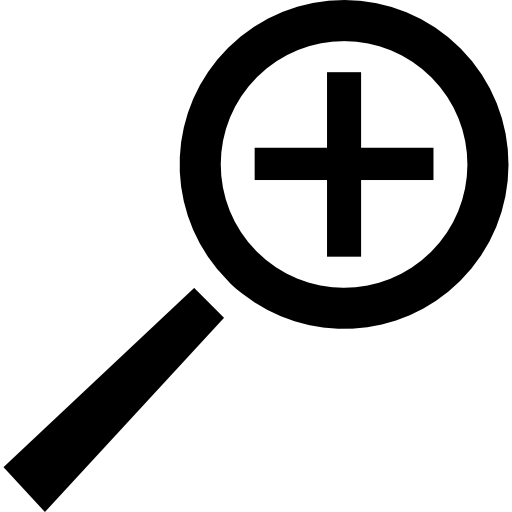



America - Front
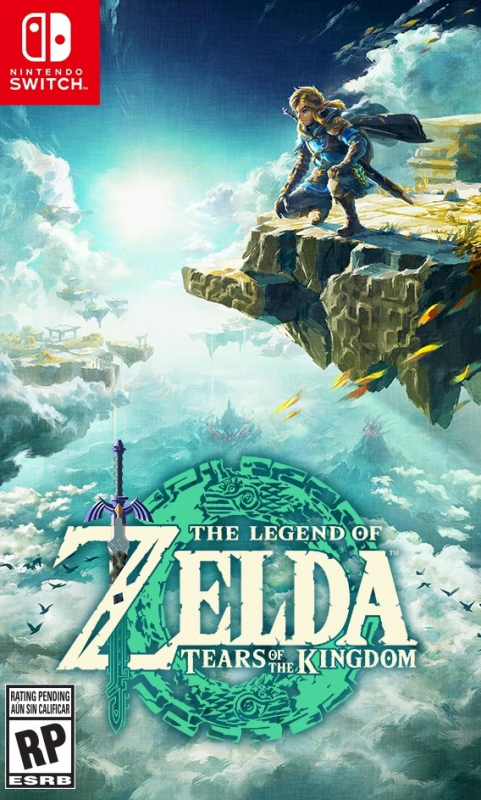

America - Back

Breath of the Wild is a tough act to follow. Arguably the best video game of all time, the 2017 Switch title ushered in a new era for The Legend of Zelda and set an impossibly high bar for future installments of the franchise. Now, six years later, the development team at Nintendo, including director Hidemaro Fujibayashi and longtime series producer Eiji Aonuma, have attempted to reach that bar, and exceed it. The result is The Legend of Zelda: Tears of the Kingdom, a direct sequel that builds upon the world, mechanics, and underlying skeleton of Breath of the Wild, while introducing more complex physical interactions and DIY opportunities than ever before.
If Tears of the Kingdom could be condensed into a single word, it would be "liberating". The game, by way of its vast open world, creative toolkit, and barrier-breaking locomotion systems, is designed deliberately to enhance player freedom and encourage invention, experimentation, and outside-the-box thinking. There are so many possibilities in this newest Zelda game, whether spatial, chemical, physical, or structural, that it would be difficult to play another action-adventure game — even Breath of the Wild — and not feel somewhat restrained.
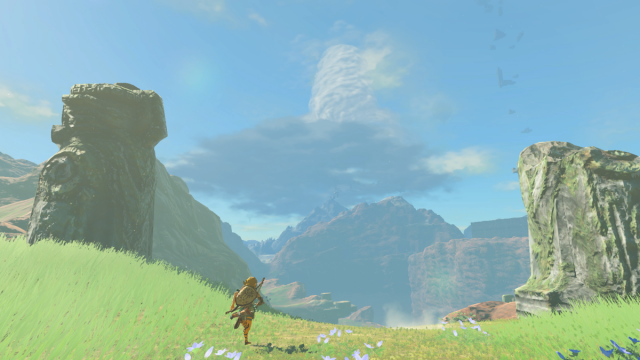
All of these possibilities come stacked upon the game’s massive, matchless open world: the kingdom of Hyrule. An enormous landmass defined by multiple discrete climate zones and dotted with towns, forts, fields, rivers, mountains, and deserts, Hyrule is a potent mixture of verisimilitude and approachability. Everything within its borders feels and seems real, thanks to lifelike biological and meteorological systems, but not so real as to deter exploration or interrupt the fun of the game. The Zelda series was built upon the combination of CRPG authenticity and arcade accessibility, and Tears of the Kingdom honors that tradition.
The downside to Hyrule is that so much of it is overly familiar. Because Tears of the Kingdom occupies the same physical space as Breath of the Wild, and features many of the same locations, people, sights, and sounds, it inevitably triggers a sense of déjà vu. The programmers at Nintendo did what they could to refresh all the old haunts, including aging characters, remodeling villages, and adding new landmarks across the immensity of Hyrule, but it’s hard to shake the feeling of "been there, done that".
Gratefully, Hyrule proper makes up only about 50 percent of the game's total explorable space. The other, more exciting half is represented by two entirely new zones: Sky Islands and the Depths. The Sky Island zone, featured prominently in pre-launch advertising for the game, is an extensive system of floating islands and archipelagos thousands of feet above the kingdom. The Depths, shrouded in secrecy ahead of launch, is the enormous subterranean world thousands of feet below the kingdom (think the Underdark from Dungeons & Dragons).

Combined, these two realms accomplish three very important things: they greatly enhance the game's novelty, necessary due to the wholesale importation of the overworld from the game’s precursor; they bestow upon Hyrule spatial freedom and vertical world design never before seen in the Zelda series; and, finally — and this is especially true of the Depths — they recapture the feelings of solitude, danger, and mystery that characterized Breath of the Wild six years ago.
This last accomplishment is especially significant because those feelings are diminished in the overworld in Tears of the Kingdom, at least in comparison to Breath of the Wild. In part this is due to the fact that both games share a map, but it's also because this "new" Hyrule has more signposting, quest-givers, and people than before. It lacks the loneliness that made its predecessor so special.
What this entry lacks in loneliness it more than makes up for in content. Due to the addition of dozens of Sky Islands and the underground world of the Depths, which together basically double the game’s already enormous footprint, there is more to see in Hyrule than ever before. There’s also more to do than ever before, thanks to an overwhelming number of tasks and projects. Tears of the Kingdom boasts 139 side quests and 60 side adventures (meatier versions of quests) in addition to its main quest lines. Compare that to 76 side quests in Breath of the Wild.

Overall, Tears of the Kingdom is one of densest, most content-rich action-adventure titles of all time. Players looking to complete all the main quests and put a significant dent in the ancillary missions should expect to spend a minimum of 90 hours with the game. Completionists can double that figure. Really, you could play it for the rest of your life, considering the endless opportunities for experimentation.
The huge horizontal and vertical sandbox that is Hyrule is extraordinary. It's completely integrated and interconnected, filled with secrets and adventures, and dominated by a heady sensation of discovery. As brilliant as it is, however, the playground tools that Nintendo gives its players to create and craft within the sandbox might be even more impressive. Indeed, this sequel manages to retain much of the experimental potential from Breath of the Wild — oriented around cooking, elemental interactions, weather systems, weapon durability, and more — and add to it via two new powers, Ultrahand and Fuse.
Ultrahand is nothing short of a total game-changer. It allows Link to grab and move objects, rotate them, and stick them to other objects. "With it," says one of the game’s characters, “you will be able to build a great number of things. Really, anything you can imagine." Indeed, the DIY possibilities embedded in Ultrahand are off the charts. You could chop down some trees and patch them together to form a makeshift raft, or you could cobble together pieces of ancient Zonaite technology — gliders, wheels, fans, rockets, batteries, etc. — to create a tank, a hovercraft, or a floating fortress. More simply, you could grab a powder keg and drop it on an unsuspecting Bokoblin.
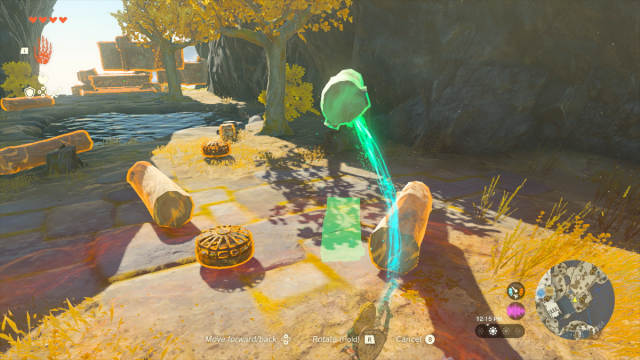
The freedom to pick up elements in the world and use them to forge bespoke vehicles, equipment, and machinery adds a bold new level of interactivity to Tears of the Kingdom that grants the game endless replay value. It feels very much like a logical extension of, and improvement on, the emergent gameplay that helped make Breath of the Wild an all-time great.
In a similar way, Fuse seems like the next evolution of the exciting improvisational fighting from Breath of the Wild. It allows Link to attach something to an equipped weapon or shield to enhance it in some way. The "something" could be pulled from the environment, like a boulder, icicle, or tree trunk, or from your inventory, for example a Like Like stone or a Moblin horn. Anything you can pick up can be fused to your weapon or shield, resulting in some wild combinations that have the potential to turn the tide of battle. Fuse a piece of topaz to a sword and, voilà, you have a lightning rod. Add a puffshroom to a shield, and watch as the monster that hits it becomes engulfed in disorienting smoke.
While it’s not technically a part of the Fuse power, you can achieve similar battlefield advantages from afar by attaching inventory materials to your arrows. Fasten a Keese eyeball to an arrow to achieve a homing missile, or use an ice fruit arrow to freeze a monster in its tracks. Combat in Breath of the Wild was already an incredibly rewarding tactical affair with room for impromptu decision-making, but Tears of the Kingdom has added to it, layering upon that winning framework additional options to tailor-make your battle plan. The results are phenomenal.

In addition to Ultrahand and Fuse, Nintendo introduces Ascend and Recall, both of which grant Link new movement options that provide quicker, easier movement throughout the game world. Ascend allows him to move upward through solid material and emerge on top of it, which proves incredibly helpful when it’s time to leave a cave or well and you’re not interested in back-tracking to the entrance. Recall, meanwhile, allows him to reverse an object’s movement until it returns to its place of origin. This empowers Link to "ride" broken pieces of Sky Islands upward from the surface. It’s also useful for moving a platform against a strong current or even returning a thrown rock to the sender.
If these new powers seem like a continuation of mechanics and gameplay systems started in Breath of the Wild six years ago, its main questline and the storytelling & dungeons that underpin it seem more like a reversal. Where the first entry in this duology embraced a laissez-faire attitude toward story, allowing players to pick up the trail of breadcrumbs at their leisure, the sequel takes an approach more typical of the franchise, with more exposition, signposting, and direct intervention in general. For Zelda fans who lamented the absence of story in Breath of the Wild, Tears of the Kingdom will certainly seem an improvement. For others, like myself, who enjoyed the original title's roundabout, hands-off narrative, this latest Zelda title rates as something of a regression.
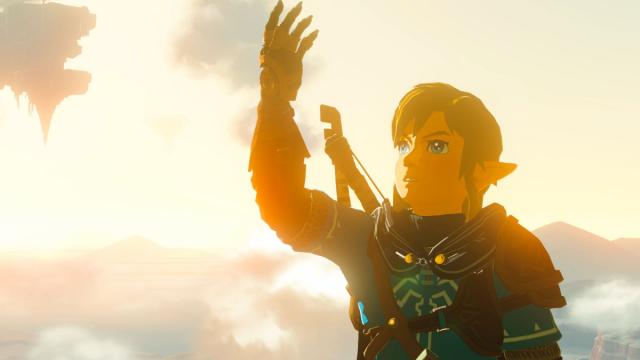
All that said, the story, not to mention the new lore that buttresses it, is captivating and often moving. It all begins several years after Breath of the Wild, in the dusty tunnels beneath Hyrule castle, from which an inky red gloom has begun to emanate. When the heroic swordsman Link and the selfless Princess Zelda go to investigate they find the source of the noxious gloom — a curious mummified corpse, which promptly awakens, drains Link of his power, and tosses Zelda into the abyss. The resurrection of this mummy sends Hyrule castle airborne, opens gaping chasms and a myriad of caves across the surface of Hyrule, and reveals ancient islands in the sky above. Link awakens an indeterminate amount of time after this event, known as the “Upheaval”, to find Hyrule in peril and the Princess still missing.
Because the story in Tears of the Kingdom takes place in the same universe as Breath of the Wild, it represents a special opportunity to reconnect with beloved characters from the first game, now older and in different spots among their peoples. It also gives never-before-seen glimpses into the technologically-advanced, long gone tribe of the Zonai and the origins of the kingdom of Hyrule. Finally, it does the three main characters of the series justice. Ganon is especially evil and sly; Link is dutiful and loyal; and Zelda is brave, kind, and wise. Really, she's the linchpin of the entire game. Not every franchise installment is truly a legend of Zelda, but this one absolutely is.
Just as the game’s story represents a course correction of sorts, its main dungeons appear to be a concession to fans who requested something akin to "classical" dungeons. Each has some elemental theme, a distinct layout and aesthetic, and a completely unique boss, which seems like a repudiation of the copy-and-paste bosses from the Divine Beasts in Breath of the Wild. By the incredibly high standards of The Legend of Zelda, none of the dungeons are spectacular — one wonders if the dungeon-designing muscle at Nintendo EPD has atrophied over the last 10 years — but fun enough. Much more enticing are the long ascents or descents to the dungeons, which have their own perils, platforming challenges, and even mini-bosses.

Everything in Tears of the Kingdom, from its surface and Sky Islands, to its Depths and dungeons, is brought to vivid life thanks to the game’s winsome art direction and visuals. Like Breath of the Wild before it, it won’t blow anyone away graphically, but the anime-inspired soft-texture art style goes a long way. Performance-wise, it's in a league of its own, not because its hits 120 frames per second at 4K resolution — it maintains 30 FPS in all but the busiest of scenes at a humble 900p when docked — but because the game never, ever buckles when so many systems and calculations are running on screen and behind the scenes. This is one of the most physically and mechanically audacious games of all time, running smoothly on the little engine that could - known as the Switch.
Topping Breath of the Wild was always going to be a monumentally tough task, but Fujibayashi, Aonuma, and the legion of artists and technicians at Nintendo came as close as humanly possible with this sequel. In terms of story, structure, and atmosphere, it’s a small step down, but in terms of gameplay systems and depth, it’s a noticeable step up. Regardless of whether it’s superior or inferior to its predecessor, Tears of the Kingdom is a staggering achievement in video game design and programming, and one of the very best games of the generation.









